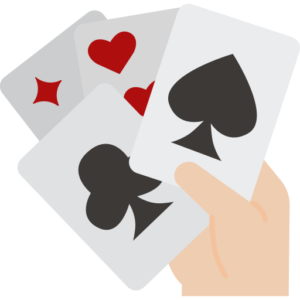Glossary Term
Check
Check
Used In: Poker
Introduction
In poker, a check is a strategic move where a player chooses not to place a bet but still remains in the game. This action can only occur if no other player has made a bet in the current round. By checking, the player decides to pass their turn without increasing the pot, allowing other players to act before the next decision is made.
The check is often used to avoid adding chips to the pot when a player feels unsure about their hand but still wants to see what others do. It allows a player to gather more information about the strength of other players' hands without committing further to the pot. Checking can be a sign of caution, or sometimes, it may be part of a larger strategy to lure opponents into betting more.
If all players check during a round, the betting round ends, and the game moves forward to the next phase. This might happen when no one feels confident enough to bet or when players are satisfied with the current state of the pot. While checking doesn’t increase the pot, it is a key decision in managing the flow of the game and can help a player maintain control over their chips.
In Depth Look
In poker, checking is a move that allows a player to stay in the game without betting. It can only be done when no one else has bet during the current round. Checking is a way to maintain control over your chips while observing the actions of other players. If a player believes their hand is not strong enough to bet but still wants to see the next card or stay in the hand, checking is often the best choice. It can also be used strategically to disguise the strength of a player’s hand, making it harder for opponents to predict their next move. However, checking is not always safe. If a player checks and others start betting, they might find themselves in a tough spot, needing to decide whether to call, raise, or fold.
The most important thing to remember about checking is that it doesn’t force the player to add chips to the pot, giving them flexibility. It can be a useful tool for both strong and weak hands, depending on the situation. For strong hands, checking can encourage opponents to bet, allowing the player to raise later and increase the pot. For weak hands, it can be a way to avoid betting too much while still holding on to a chance to win. It’s important to use checking in the right spots—doing so at the wrong time might lead to missed opportunities or give away too much information about your hand.
Key points:
- Checking can only be done when no one has bet in the current round.
- It helps players manage their chips without committing more to the pot.
- Checking is often used to gain information and control the flow of the game.
Mechanics
In poker, the mechanics of checking are simple but important. When it's your turn to act and no one has bet before you, you have the option to check instead of placing a bet. To check, you simply tap the table or verbally declare “check.” This signals that you don’t want to bet but still wish to stay in the hand. The action then moves to the next player in turn. If every player checks in a round, the betting phase ends, and the game moves to the next stage, whether it's the next community card being dealt or the showdown if it's the final betting round.
The mechanics of checking can vary slightly depending on the type of poker game being played. For example, in no-limit Texas Hold'em, checking is common in early betting rounds, particularly when players have weak hands or want to assess their position. In contrast, in games like Omaha or Stud, players may check to control the pot size or avoid committing too many chips. A check doesn’t change the action in the round beyond allowing the next player to act, but it can have strategic implications, depending on the situation and the hands involved. Checking, when done at the right time, can influence the outcome of the hand without putting additional chips into the pot.


Illustrated Example
Let’s consider a hand of no-limit Texas Hold'em to better understand how checking works. Imagine you’re playing with four players at the table, and you’re in the small blind position. The dealer deals the community cards: 7♠, 9♣, and J♦. You hold 5♠ 8♠ in your hand. No one has placed a bet yet, so you decide to check. By doing so, you stay in the hand without adding more chips to the pot. The action then moves to the next player, who also checks. The next two players do the same. At this point, all four players have checked, and the round ends without any betting. The next community card is dealt, and the game continues.
In this example, checking allowed you to see another card without risking more chips. Your hand, 5♠ 8♠, isn’t strong enough to bet yet, but you’re hoping that another spade or a 6 will come, giving you a straight or a flush. By checking, you avoid putting money into the pot unnecessarily while still staying in the hand to see if your situation improves. If the next card improves your hand, you can then make a bet or raise, potentially building the pot. If it doesn’t improve, you can continue to check or fold without losing too many chips.
| Player | Action | Cards Held | Community Cards | Pot Size |
|---|---|---|---|---|
| Player 1 (You) | Check | 5♠ 8♠ | 7♠ 9♣ J♦ | $0 |
| Player 2 | Check | K♠ Q♣ | 7♠ 9♣ J♦ | $0 |
| Player 3 | Check | 4♣ 10♠ | 7♠ 9♣ J♦ | $0 |
| Player 4 | Check | A♠ 2♠ | 7♠ 9♣ J♦ | $0 |
In this table, each player checks after the community cards are revealed. None of the players bet, and the round moves on without any action in the pot. This illustrates how checking allows players to keep their options open without risking more chips.
Player Perspective
From a player's perspective, checking can be a vital tool in managing the flow of the game. When you check, you are choosing to stay in the hand without committing more chips. This decision can be made for several reasons. For example, you might be holding a weak hand and don’t want to risk further investment. Alternatively, you might have a strong but not yet completed hand, such as a flush or straight draw, and checking allows you to see the next card without escalating the pot. It can also be a tactic to avoid showing strength, keeping opponents uncertain about the value of your hand. By checking, you can gather more information from how others bet before deciding your next move.
Checking is also about control and timing. If you’re in a late position and other players have checked before you, it may be wise to check as well, especially if you’re uncertain about the strength of your hand or want to control the pot size. If you’re in an early position, checking can give you more time to assess how the other players react and whether they place a bet. A check can also be a way to induce betting from opponents who may feel confident enough to make a larger bet. At the same time, it can serve as a way to avoid overcommitting when you don’t yet have a strong enough hand to make a significant bet. Ultimately, the decision to check or not depends on the player’s strategy, hand strength, and the actions of others at the table.
Conclusion
In conclusion, checking is a fundamental part of poker strategy that allows players to control the pace of the game without committing more chips. It offers the flexibility to stay in the hand and gather information while avoiding unnecessary risk. Whether used to preserve chips, induce bets from opponents, or simply wait for a better hand, checking is an essential tool in managing both weak and strong hands. Understanding when and how to check can greatly influence the outcome of a hand and help players make more informed, strategic decisions throughout the game.
The Top Online Casinos for Playing Poker
These platforms prioritize player satisfaction by providing intuitive interfaces, seamless gameplay experiences, and robust security measures to ensure a fair and enjoyable environment for all users.


Author
Branimir Ivanov | Senior News Contributor







